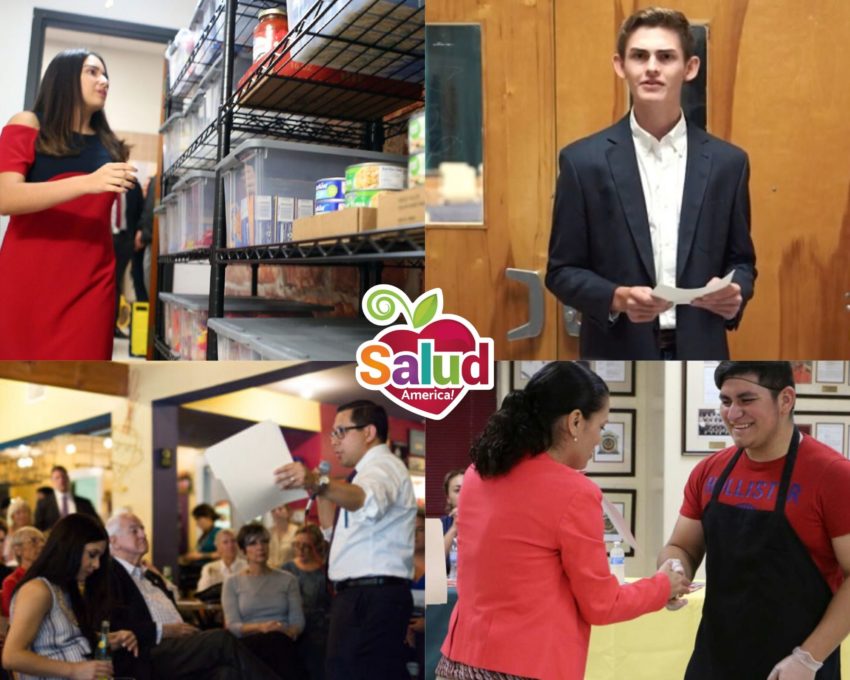
Share On Social!
U.S. Latinos face high levels of poverty, food swamps, and food insecurity—living without reliable access to enough affordable, nutritious food.
In Texas, the food insecurity rate is 14.3%.
That’s why Texas State Representative Diego Bernal championed legislation that would allow schools to set up school food pantries.
Because of this law, schools are helping those who are hungry and food insecure as well as reducing food waste.
The law has also inspired others to create change and do good for the community, like Jenny Arredondo, Samantha Almaraz, and Pablo Ramirez.
Diego Bernal & School Food Pantries
Bernal was heartbroken after touring Texas schools and seeing students go hungry, even as “perfectly edible food” was being thrown away in cafeterias.
He wanted to schools to be able to save the leftovers to give to food-insecure students.
So he championed House Bill 367. In 2017, House Bill 367 became Senate Bill 725, The Student Fairness in Feeding Act. It was signed into law in June 2017 and took effect Sept. 1, 2017.
The law states schools now can start “school food pantries.” The pantries can accept and store donated food and surplus cafeteria food, and distribute that food to hungry students.
Basically, schools can donate leftover food to themselves.
“If they just want to test it out and do bottled water and unopened peel-top cereal and wrapped granola bars, cool,” Bernal has said. “If they want to spend money and add refrigerators, that’s also great. We don’t dictate how they should do it.”
Bernal continues to visit schools. He has a desire to ensure policies and system stay focused on positive impacts on student health and wellbeing.
School Food Pantries Take Off in San Antonio
Jenny Arredondo, senior executive director of child nutrition at San Antonio ISD (91% Latino), knew lots of students face food insecurity in her district.
“Food insecurity does exist and hunger doesn’t just end when the bell rings,” Arredondo said. “If we can help [students], we are going to help them.”
Arredondo started looking for innovative ways to help.
That’s when she learned about Senate Bill 725. Intrigued, she started laying the groundwork to start school food pantries across the district.
Arredondo began the process by informing campuses about the new rule, and to contact her if interested. She gave each campus representative packet with information about what foods and drinks are able to donated and stored to meet food safety regulations.
Now, there are school food pantries at more than 10 campuses in the district.
“With the demographics of San Antonio ISD, implementing a food pantry was a necessity,” Arredondo said.
Students Take a School Food Pantry to the Next Level in South Texas
In McAllen, Texas, Lamar Academy 10th-graders Samantha Almaraz and Pablo Ramirez heard about Senate Bill 725.
They had seen classmates struggle with hunger and poverty in their 85% Latino border town.
So they started a school food pantry by working with their parents, school leaders, and using the Salud America! “School Food Pantry Action Pack” as a guide for their efforts.
They called it “The Energy Bar!”
“We’re surrounded by people who are hungry and that don’t get food,” said Samantha, who with Pablo is in the International Baccalaureate program at Lamar Academy in McAllen ISD. “They tell us, ‘I don’t have food waiting for me at home.’”
But The Energy Bar goes further than the traditional school food pantry.
They expanded the pantry to a new level by accepting donations of deodorant, shampoo, toothpaste, etc. They also conduct fundraisers to buy more canned goods and basic necessities to stock in the pantry.
“We’re hoping the district will become a zero-waste district and be able to provide all their students with necessary goods,” Pablo said.
READ PABLO AND SAMANTHA’S STORY!
Start a School Food Pantry at Your School!
You can be like Samantha and Pablo in McAllen.
Or like Jenny Arredondo, the nutrition leader at San Antonio who helped start more than 10 school food pantries at district campuses.
You can start by using the four-step Salud America! School Food Pantry Action Pack:
- Start the Conversation. Use the model emails and talking points to talk to decision-makers about the need for School Food Pantries.
- Build Support. Use the model letter campaign, handout, emails, and presentation to build support for your pantry.
- Plan and Implement a Pantry. Use Salud America!‘s “Quick Guide” and real templates from San Antonio ISD—which implemented 10 School Food Pantries—to craft your own.
- Promote Your Pantry. Use the printable signs and shareable social media graphics to alert students, parents, and the community to your big change.
Why do this?
Because research shows children who go to school hungry are more likely to have poorer grades and mental health issues. This makes it hard to succeed academically, socially, and emotionally.
So help kids at your school with a school food pantry today!
Explore More:
Healthy FoodBy The Numbers
142
Percent
Expected rise in Latino cancer cases in coming years
This success story was produced by Salud America! with support from the Robert Wood Johnson Foundation.
The stories are intended for educational and informative purposes. References to specific policymakers, individuals, schools, policies, or companies have been included solely to advance these purposes and do not constitute an endorsement, sponsorship, or recommendation. Stories are based on and told by real community members and are the opinions and views of the individuals whose stories are told. Organization and activities described were not supported by Salud America! or the Robert Wood Johnson Foundation and do not necessarily represent the views of Salud America! or the Robert Wood Johnson Foundation.



